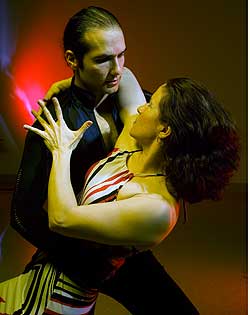Arash Sabet already has earned a bachelor’s degree in biomedical engineering and a master’s degree in mechanical engineering from WUSTL, in addition to creating several patented medical device inventions, successful start-up companies and a long list of community service projects.
So why does he need another degree?

“Arash is a sort of Renaissance man, who blends knowledge of arts, science, music, literature and now … business,” says Madeleine Hackney, Sabet’s professional ballroom dancing partner.
Ballroom dancing is one of the many side interests in Sabet’s life, along with Ironman competitions. Perhaps “Renaissance man turned 21st-century global entrepreneur” might be a better way to describe Sabet, who receives an MBA May 15.
“People have always told me that solving problems is something I do well, and that’s why entrepreneurship fits so well with what I want to do,” Sabet says. “You are making something that didn’t exist before, but there is a need for it.”
Sabet’s enthusiasm for invention and creativity is part of his DNA. His family left its native Iran during the Iran-Iraq war when Sabet was 6. They came to St. Louis to live with Sabet’s uncle, who is a physician.
His father is an engineer, his mother a pharmacist and his older brother a physician in San Francisco. From an early age, Sabet exhibited a keen sense of curiosity about how things work.
One of his first inventions, when he was in second grade, was a mechanized car made out of a tissue box. From there, he moved to repairing neighbors’ bicycles. During a visit to Iran while in middle school, Sabet took apart and repaired his aunt’s broken toilet in a feat that has become family legend.
When Sabet entered WUSTL after attending the summer scholar program in biology, he thought he wanted to be a surgeon. But he discovered his mechanical talents were a perfect match for doctors in need of technical solutions to medical problems.
Working with high-school friend and physical therapist Keith Cronan, Sabet invented a disposable physical therapy device aimed at restoring jaw function in people afflicted with TMJ, temporomandibular joint injury.
The company Sabet created to manufacture and market the device won $20,000 in the Olin Cup competition for entrepreneurial startups in 2008.
Sabet currently has five medical devices patented or patent pending — many involving tools for neurosurgery and otolaryngology developed with WUSTL medical school professors.
“I want to lead a company that is on the forefront of developing advanced sensory prosthetics, which serve to help individuals regain lost functions to communicate or interact with the world around them,” Sabet says.
“As a physician, your capacity to interact with people is one-to-one, but if you can solve a medical condition with technology that could spread worldwide and help more people, that’s fantastic!”
Sabet says going to business school was necessary to succeed in getting his inventions to market and reaching the largest audience possible.
“Arash is a true entrepreneur,” says Ken Harrington, director of the Skandalaris Center for Entrepreneurial Studies. “He invents, he is good with people, and he moves markets with ideas and action.”
Sabet will put his entrepreneurial skills to work soon after graduation, when he heads to Asia for five months as a Kauffman Foundation Singapore Scholar. It will be an opportunity to meet and exchange ideas with other young inventors, scientific innovators and business leaders from around the world.
Sabet’s ties to the St. Louis are strong, and his legacies within the WUSTL community are many.
He founded the Feed St. Louis program that delivers 10,000 pounds of surplus food from WUSTL food services to area homeless shelters each year.
His latest nonprofit venture could touch the lives of hundreds of schoolchildren.
St. Louis Dancing Classrooms is a social development curriculum, based on a program initiated in New York City and documented in the 2005 movie “Mad Hot Ballroom.”
The goal is to teach fifth graders respectful interaction and teamwork through ballroom dancing.
Dancing, Sabet says, requires many of the same skills it takes to be a good entrepreneur, and his passion for both undoubtedly will continue to fuel his success in ballrooms and boardrooms.